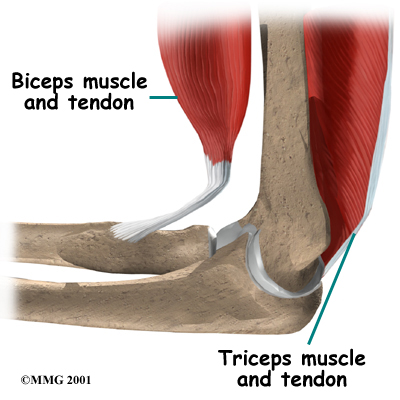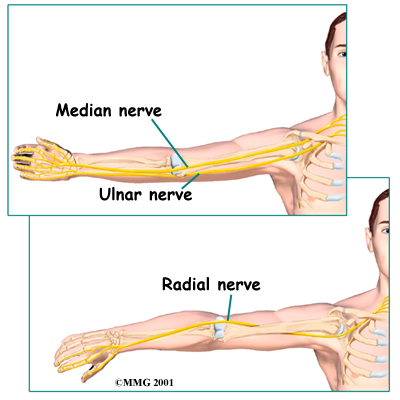The important structures of the elbow can be divided into
several categories. These include
- bones and joints
- ligaments and tendons
- muscles
- nerves
- blood vessels
Bones and Joints
The bones of the elbow are the humerus (the upper
arm bone), the ulna (the larger bone of the forearm,
on the opposite side of the thumb), and the radius
(the smaller bone of the forearm on the same side as the
thumb). The elbow itself is essentially a hinge joint,
meaning it bends and straightens like a hinge. But there is
a second joint where the end of the radius (the radial head) meets the humerus. This joint is
complicated because the radius has to rotate so that you can
turn your hand palm up and palm down. At the same time, it
has to slide against the end of the humerus as the elbow
bends and straightens. The joint is even more complex
because the radius has to slide against the ulna as it
rotates the wrist as well. As a result, the end of the
radius at the elbow is shaped like a smooth knob with a cup
at the end to fit on the end of the humerus. The edges are
also smooth where it glides against the ulna.
Articular cartilage is the material that covers
the ends of the bones of any joint. Articular cartilage can
be up to one-quarter of an inch thick in the large,
weight-bearing joints. It is a bit thinner in joints such as
the elbow, which don't support weight. Articular cartilage
is white, shiny, and has a rubbery consistency. It is
slippery, which allows the joint surfaces to slide against
one another without causing any damage.
The function of articular cartilage is to absorb shock
and provide an extremely smooth surface to make motion
easier. We have articular cartilage essentially everywhere
that two bony surfaces move against one another, or
articulate. In the elbow, articular cartilage covers
the end of the humerus, the end of the radius, and the end
of the ulna.
Ligaments and Tendons
There are several important ligaments in the
elbow. Ligaments are soft tissue structures that connect
bones to bones. The ligaments around a joint usually combine
together to form a joint capsule. A joint capsule is
a watertight sac that surrounds a joint and contains
lubricating fluid called synovial fluid.
In the elbow, two of the most important ligaments are the
medial collateral ligament and the lateral collateral ligament. The medial
collateral is on the inside edge of the elbow, and the
lateral collateral is on the outside edge. Together these
two ligaments connect the humerus to the ulna and keep it
tightly in place as it slides through the groove at the end
of the humerus. These ligaments are the main source of
stability for the elbow. They can be torn when there is an
injury or dislocation to the elbow. If they do not heal
correctly the elbow can be too loose, or unstable.
There is also an important ligament called the annular ligament that wraps around the radial
head and holds it tight against the ulna. The word
annular means ring shaped, and the annular ligament
forms a ring around the radial head as it holds it in place.
This ligament can be torn when the entire elbow or just the
radial head is dislocated.
There are several important tendons around the
elbow. The biceps tendon attaches the large biceps
muscle on the front of the arm to the radius. It allows
the elbow to bend with force. You can feel this tendon
crossing the front crease of the elbow when you tighten the
biceps muscle.

The triceps tendon connects the large triceps
muscle on the back of the arm with the ulna. It allows
the elbow to straighten with force, such as when you perform
a push-up.
The muscles of the forearm cross the elbow and attach to
the humerus. The outside, or lateral, bump just above the
elbow is called the lateral epicondyle. Most of the muscles that
straighten the fingers and wrist all come together in one
tendon to attach in this area. The inside, or medial, bump
just above the elbow is called the medial epicondyle. Most of the muscles that
bend the fingers and wrist all come together in one tendon
to attach in this area. These two tendons are important to
understand because they are a common location of
tendonitis.
Muscles
The main muscles that are important at the elbow have
been mentioned above in the discussion about tendons. They
are the biceps, the triceps, the wrist extensors
(attaching to the lateral epicondyle) and the wrist
flexors (attaching to the medial epicondyle).
 Nerves
Nerves
All of the nerves that travel down the arm pass across the elbow. Three main nerves begin
together at the shoulder: the radial nerve, the
ulnar nerve, and the median nerve. These
nerves carry signals from the brain to the muscles that move
the arm. The nerves also carry signals back to the brain
about sensations such as touch, pain, and temperature.

Some of the more common problems around the elbow are
problems of the nerves. Each nerve travels through its own
tunnel as it crosses the elbow. Because the elbow must bend
a great deal, the nerves must bend as well. Constant bending
and straightening can lead to irritation or pressure on the
nerves within their tunnels and cause problems such as pain,
numbness, and weakness in the arm and hand.
Blood
Vessels
Traveling along with the nerves are the large vessels
that supply the arm with blood. The largest artery is the brachial artery that travels across the front
crease of the elbow. If you place your hand in the bend of
your elbow, you may be able to feel the pulsing of this
large artery. The brachial artery splits into two branches just below the elbow: the
ulnar artery and the radial artery that
continue into the hand. Damage to the brachial artery can be
very serious because it is the only blood supply to the
hand.
